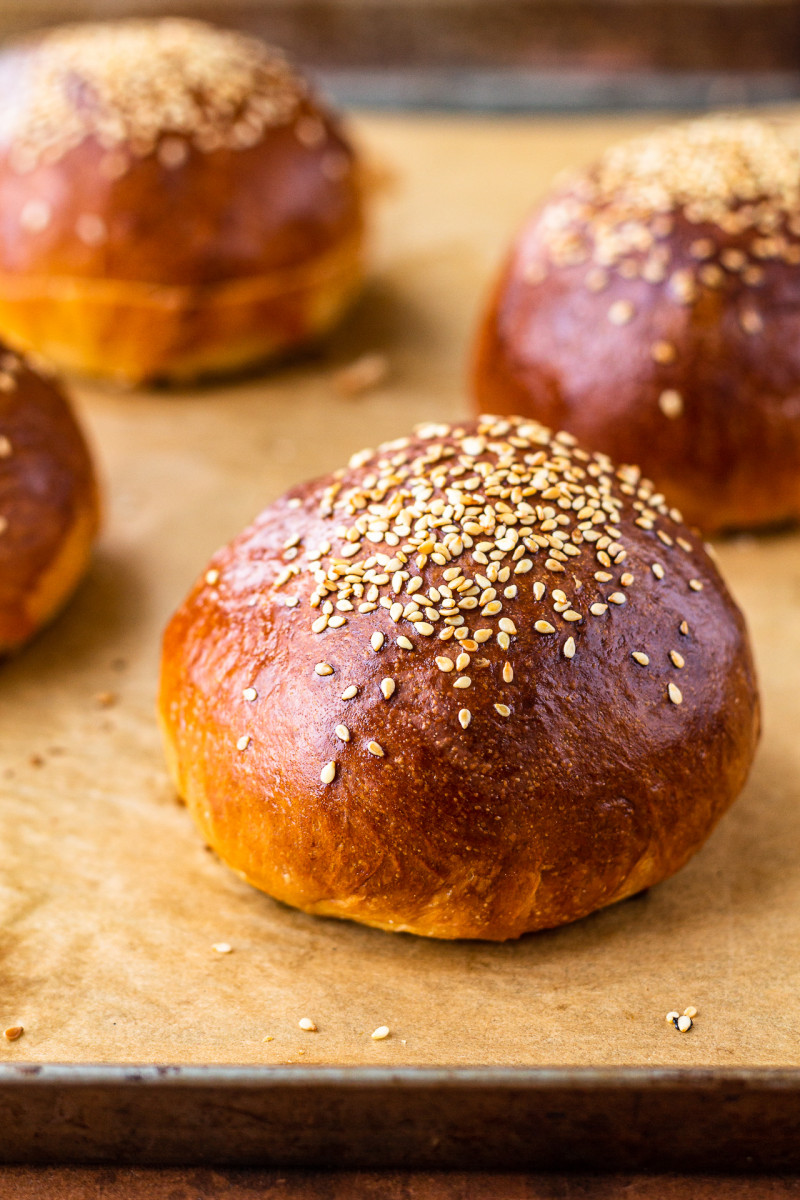
I’ve had a hankering for pain perdu (French toast) and homemade burgers lately so I’ve decided to make myself some ‘buttery’ vegan brioche buns first. They are not hard to make and really delicious – better than anything you could buy in most places – unless you are lucky enough to live near an artisanal vegan bakery.
Traditional brioche dough is essentially a bread dough enriched with prolific quantities of eggs and butter. As both of those are off limits for me, I used vegan butter in the place of dairy butter and soy milk and a touch more yeast to mimic the effects of egg. The result is a fluffy and indulgent bun that makes a perfect base for vegan burgers or, once a little stale, French toast.
If you own a fancy stand mixer or a food processor with a bread dough making function, this dough will cause you no issues whatsoever, but if you don’t, don’t worry. I personally make these by hand and I documented the process as best as I could while trying not to get all of my computer and photography equipment caked in goo 😉 . Below are detailed step by step photos that will help you make these with confidence. Enjoy!
MORE ABOUT THE INGREDIENTS

FLOUR: You could make brioche buns with 100% all purpose flour or with a mixture of all purpose and bread flour. Bread flour contains more gluten making these a little chewier, while all purpose flour keeps them soft. I like to use a mixture of the two flours for this reason but if you are after a super soft texture, use 100% all purpose flour.
SUGAR: a small amount of superfine (known as caster in the UK) is used to sweeten the dough, depending on how you are planning to use these buns you are welcome to decrease or increase the amount of sugar by a tablespoon or so.
YEAST: yeast is what gives these buns rise and a lovely, fluffy texture. It is important to use the correct type of yeast and to activate it correctly. I tend to use instant yeast, which is a type of powdered yeast that can be added directly into the flour and does not require any prior activation. If you were to use what is labelled as active dry yeast, you need to activate it in some of the liquid allocated for this recipe first, before adding to the dry ingredients.
SALT: if you are usig unsalted vegan butter, add anything between a quarter and a half a teaspoon of salt to the dough (classic bread forumla uses 1 tsp of salt for half a kilogram/ 4 cups of flour). If using salted butter, you may still want to add a pinch of so, go by your taste and proceed with caution on your first attempt.
VEGAN BUTTER: brioche a type of enriched bread meaning it is a basic bread dough with a heavy dose of eggs and solid fat (traditionally butter), which gives it a much better mouthfeel. When it comes to making the vegan version, you can simply use vegan butter block (Naturli is my favourite) or coconut oil (I like using this fragrance-free version), which stays solid in cold temperatures. I personally prefer the former especially when incorporating the fat by hand, which can get very messy and coconut oil, which starts melting from the heat of your hands, makes it even more so. In terms of replacing eggs, I use soy milk as, like eggs, it’s rich in protein, but other plant milks work just as well.
PLANT MILK: I like using soy milk in a recipe like this as it’s rich in protein and traditional brioche dough contains protein-rich eggs, but any thin plant milk (or even water) will work too. The amount is given as a guide as different flours have different absorbency levels. Once you’ve added the bulk of your liquid to the flour, proceed with caution – adding the rest in one teaspoon increments as needed.
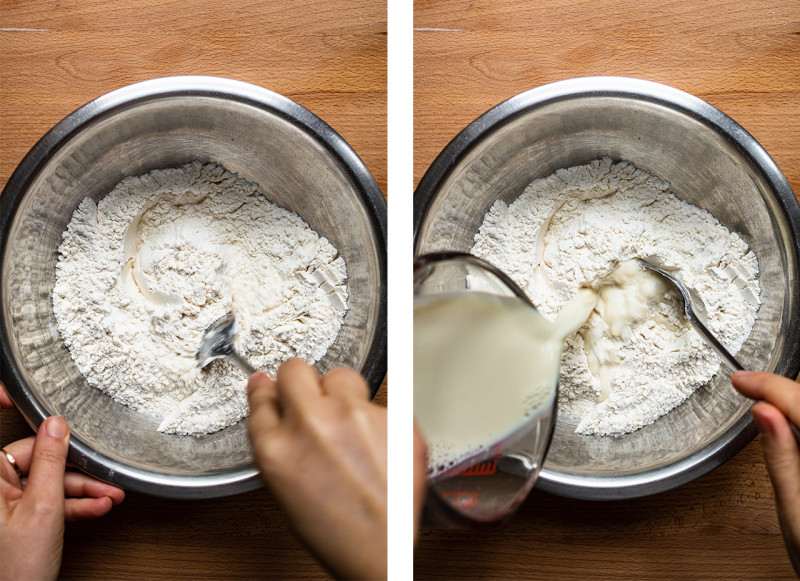
Combine both flours, instant yeast*, sugar and salt in a mixing bowl. Once combined, trickle in plant milk while mixing it into dry ingredients with a spoon first.
*Double check you have the correct type of yeast, if your yeast isn’t instant, you will need to activate it in a portion of liquid allocated to this recipe first and only then add the activated yeast to the dry ingredients.
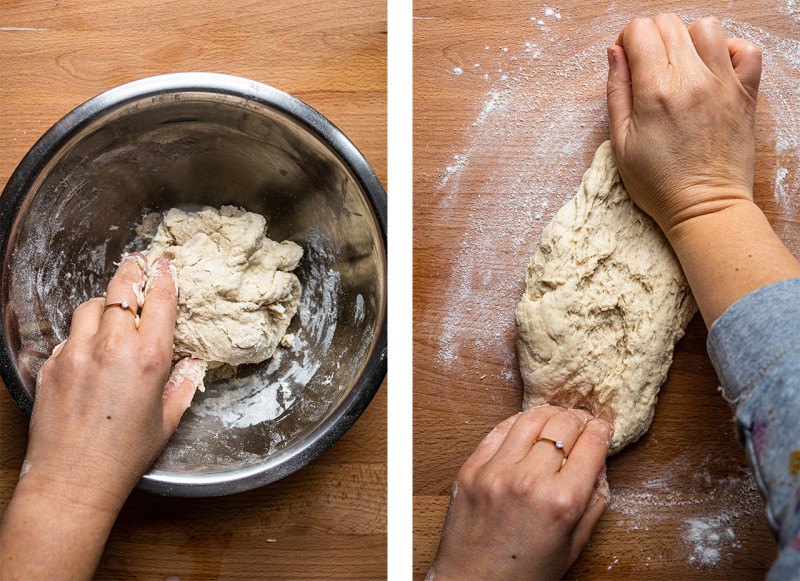
Once scraggly dough forms empty the bowl’s content onto the counter. Knead until elastic and smooth, for about 8 minutes if kneading by hand (the dough should be soft and slightly tacky, but manageable) or 3 minutes on medium speed in a standing mixer. If kneading by hand, make sure you strech the dough in all directions – hold one end of the dough with the heel of your non-dominat hand and stretch the other end with your dominant hand. Gather the dough together into a ball, rotate that ball by 30 degrees and repeat.

Once your dough is smooth, shape into a flat disc. Place a couple of cubes of vegan butter in the middle of the disc and fold the edges of the disc over the butter. Carry on kneading, gradually (that’s important) adding more butter as you go along. It’s a lot of butter so it will get messy, but with a lot of patient kneading the butter will get absorbed and the dough will come together again. A bench scraper or an old (clean) bank card comes in useful at this stage.
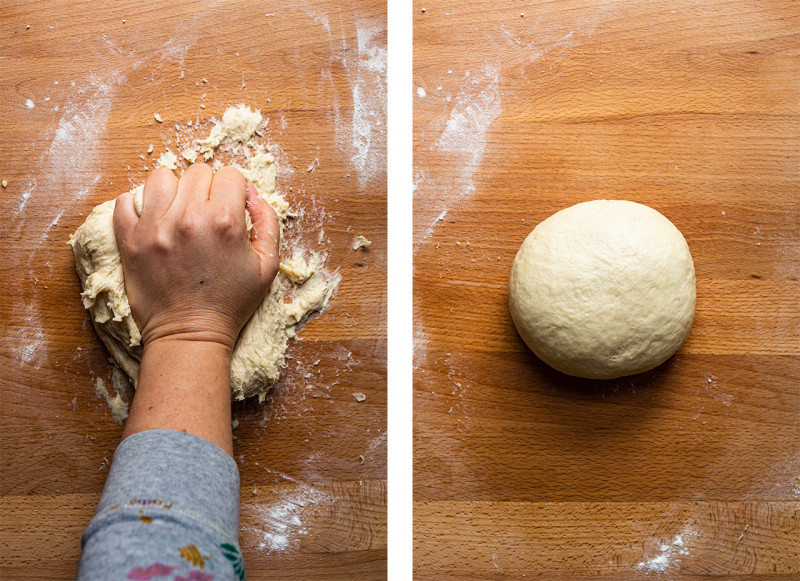
I found that from the point I started incorporating the fat, the dough needed as long as 20-25 minutes of vigorous kneading to become smooth and supple again. Do not be tempted to add any flour at this point, the dough will come together again, be patient. On the right is what my dough ball looked like after 25 minutes of consistent kneading.
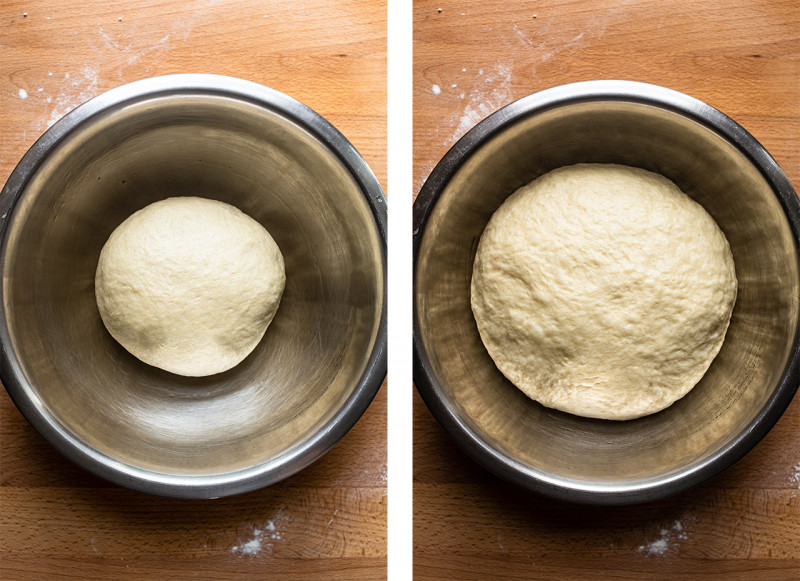
Once your dough becomes supple and shiny again, place it in a lightly oiled bowl covered with a kitchen towel and set aside to proof. You can either proof it overnight in the fridge or at ambient temperature (for 2-3 hrs) until it roughly doubles in size. I find it helpful to take a picture of the dough with my phone at the start.

Punch risen dough with your fist to deflate. Take it out of the bowl, shape into a ball and place it on the counter. Divide the dough ball into 4 (or 8) identical portions – I recommend using kitchen scales for this.

Shape each portion into a money sack first by pulling the dough around the circumference of each ball and gathering it at the bottom. Place the ball on the counter seam down and roll it against the counter with your cupped hand (don’t press down) until the surface of the ball becomes taut and smooth.

Arrange shaped buns on a prepared baking tray, cover with a kitchen towel and allow them to rise again. They should look puffed up and about 20% bigger (which, depending on the temperature will take about 1hr). Once risen, glaze the buns, sprinkle with seeds (if you like) and bake.


- 125 g / 1 cup bread (strong) flour*
- 125 g / 1 cup plain flour, plus extra for dusting
- ½ tsp fine salt*
- 25 g / 2 tbsp caster sugar or maple syrup
- 6 g / 2 tsp instant dried yeast*
- 180 ml / ¾ cup lukewarm plant milk (soy is best)
- 60 g / 2.1 oz vegan butter (I used Naturli), cubed
8 large buns
- 250 g / 2 cups bread (strong) flour*
- 250 g / 2 cups plain flour, plus extra for dusting
- 1 tsp fine salt*
- 50 g / ¼ cup caster sugar or maple syrup
- 12 g / 4 tsp instant dried yeast*
- 360 ml / 1½ cups lukewarm plant milk (soy is best)
- 120 g / 4.2 oz vegan butter (I used Naturli), cubed
GLAZE & TOPPINGS
- 10 ml / 2 tsp maple syrup or sugar
- 45 ml / 3 tbsp plant milk
- 5 ml / 1 tsp all purpose soy sauce
- sesame seeds or poppy seeds (optional)
- Place both flours, salt, sugar and instant yeast in a large bowl. Mix well. If using maple syrup, mix it in with 150 ml (½ cup + 2 tbsp) (or 300 ml / 1¼ cups if making 8) of plant milk and add in the next step. You can use a standing mixer with a dough hook instead of making it by hand.
- Add plant milk. Mix well with a spoon and then your hands. If the dough is not coming together and there are dry bits, add a touch more plant milk, teaspoon by teaspoon. If using a mixer, add milk gradually while running the mixer on the lowest speed, until the dough comes together.
- Once the dough has stuck together, turn it out on to a work surface and knead until elastic and smooth – about 8 minutes by hand or for 3 minutes on a medium setting if using a mixer. This dough is meant to be soft and a little tacky but managable. This first phase of kneading is important as it allows the gluten to develop before you add fat, which hinders gluten development.
- Form the dough into a flat disc and pile some of the vegan butter on top of it, close the dough over the butter and start kneading adding more butter cubes as you go along. If using a mixer, add butter gradually while processing on the lowest speed. Occasionally, you may need to scrape the bowl down and reposition the dough.
- At this point the dough will be very slippery and messy and look like it’s been ruined (see photos). It will come together again, but it needs to be patiently kneaded for about 20-25 minutes if kneading by hand or about 10 minutes if using a mixer.
- Once the dough is smooth, elastic and glossy again, place in a lightly oiled bowl (oil the top of the dough ball too), cover with cling film and let it proof in the fridge overnight or in a warm place until it doubles in size (about 2-3 hrs). I find it helpful to take a photo of the dough at this point to be able to gauge if it’s risen enough.
- Once the dough has risen, punch the air out of it. Weigh the dough ball and divide it into 4 (or 8) equal pieces. You could also make 5 (or 10) smaller buns if you wish.
- Shape each portion of the dough into a money sack. Place it, seam down, on a lightly floured surface. Cover it with a cupped head and roll it against the surface for about 30-60 seconds until you start feeling the bun’s surface getting taut.
- Arrange shaped buns on a paper lined baking tray making sure there is plenty of room around each bun. If making larger amount, use two trays and bake them one after another.
- Cover the buns with a kitchen towel and allow them to rise for the second time. They should look puffed up and about 20% bigger, which depending on the ambient temperature will take approximately 1 hr.
- Preheat the oven to 200° C / 390° F and fill a small baking dish with 240 ml / 1 cup of water.
- Mix sugar with plant milk and soy sauce until dissolved. Glaze the buns and sprinkle with seeds (if using).
- Place baking dish with water at the bottom of the oven, bake the buns for about 15 minutes uncovered, then cover loosely with a piece of foil and continue baking for further 10 minutes.
- Allow the buns to cool down completely before cutting (serrating bread knife works best). Store away from moisture for up to 3 days or freeze for 2-3 months, allow to defrost by leaving on the counter overnight.
*SALT: if your vegan butter contains salt, you may want to add no salt or use less than half of the stated amount. Err on the side of caution when making for the first time.
*YEAST: make sure to use the correct type of yeast and to activate it properly (if needed). I use instant yeast, which requires no prior activation and is added directly into the flour. If using active dry yeast, you need to activate it in liquid (use portion of the liquid allocated to the recipe) BEFORE adding to the dry ingredients. Read instructions on the packet to be sure.
This recipe makes 4 or 8 buns with approximately 9 cm / 3.5 inches diameter at their widest point.

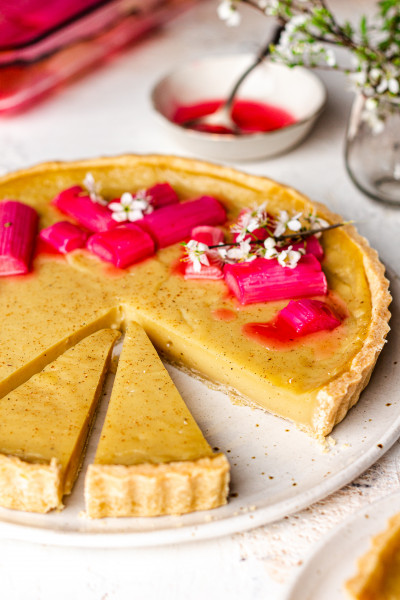
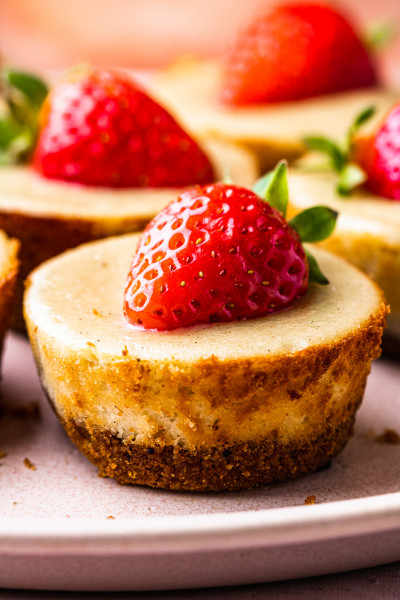



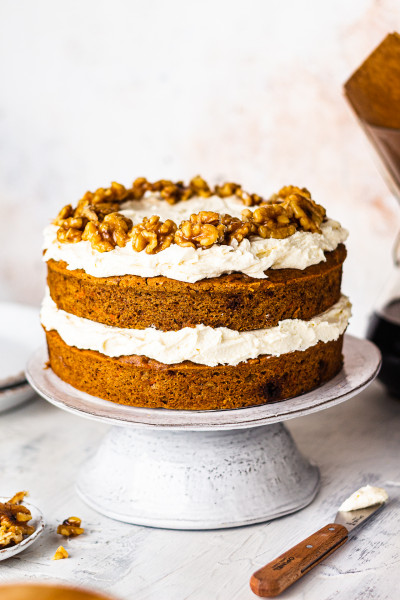

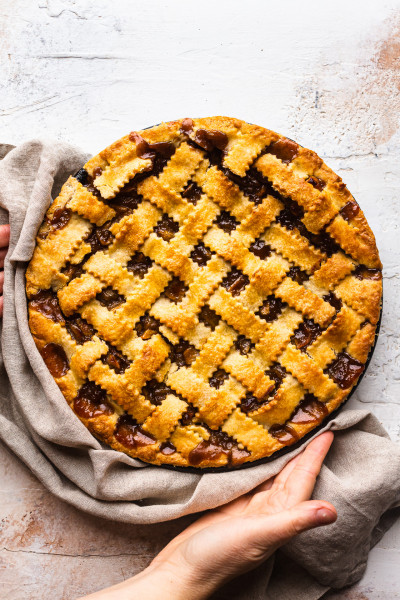
thanks
Unfortunately not for the time being. Brioche dough relies on gluten development very heavily so making it with GF flour is a big challenge. I am fairly sure that it is possible to achieve a good enough (it's never going to be quite the same) result but that requires extensive recipe development, I'm afraid. Ania
Bread like this relies on gluten development for its texture so I am pretty sure it won't work. You could probably achieve decent enough results adding starches, gums or other binders (like psyllium) to the GF flour mix, but that would require a lot of experimentation before you achieve a satisfying result. Ania
Yes, it should work fine but the baking time needs to be extended for sure. My guess is about 40 minutes if you use 500 g flour to make the bread and be sure to protect the top from browing too much. Hope this helps and thank you for your kind words about my recipes. x Ania